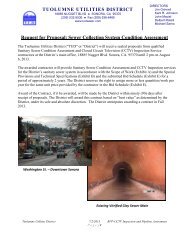Historic Resource Evaluation Project - Tuolumne Utilities District
Historic Resource Evaluation Project - Tuolumne Utilities District
Historic Resource Evaluation Project - Tuolumne Utilities District
You also want an ePaper? Increase the reach of your titles
YUMPU automatically turns print PDFs into web optimized ePapers that Google loves.
1850s Gold Rush. As many as 10,000 miners came to the Stanislaus River area by 1849<br />
(Hall 1978), and importantly, the ethnic composition was diverse, leaving archaeological<br />
sites with distinctive remains. Remnants from this mining era include stacked rock<br />
features such as walls, alignments, waste rock piles, stone ovens, buildings, and road<br />
embankments. Landscape alterations, largely the result of placer mining operations,<br />
occasional platforms (the foundations for tents or shacks), artifact scatters, quarries, and<br />
mills are also found from this era.<br />
Gold was mined in places remote from the supply centers of the time; vast amounts of<br />
food, tools, and basic supplies had to be transported to the gold country, virtually<br />
overnight. Such a need led to the development of towns and extensive road systems, both<br />
of which left developed archaeological remains. Subsequent economic and social<br />
developments generated cultural remnants such as logging camps, homesteads, hard-rock<br />
mines, ranches, and other indications of historic activities. All these activities, especially<br />
the mines and the camps, required a dependable year-round supply of water in what was<br />
otherwise a summer-drought location.<br />
CURRENT PROJECT<br />
At the request of Tom Scesa, TUD <strong>District</strong> Engineer, Foothill <strong>Resource</strong>s, Ltd., Francis<br />
Heritage, LLC, and Far Western Anthropological Research Group, Inc., conducted a<br />
survey and evaluation of the thirteen identified resources in August, September and<br />
October of 2011. The work, authorized under TUD’s 2008 Strategic Plan (BHI 2008:18-<br />
20), was carried out under the direction of Judith Marvin, project manager, historian,<br />
architectural historian and principal author (Registered Professional Historian No. 525).<br />
Charla Francis, Archaeologist and co-author (Registered Professional Archaeologist No.<br />
10518), prepared the archaeological site records (Appendix A) and contributed to the<br />
reports. Archaeological technicians Linda Thorpe, Foothill <strong>Resource</strong>s; Meagan<br />
O’Deegan, Stantec Consulting Services Inc.; and Rebecca Kellawan and Adelina Asan,<br />
Far Western, conducted the archaeological survey and field recordation, while Terry<br />
Brejla of Foothill <strong>Resource</strong>s conducted archival research and edited the document.<br />
EVALUATION<br />
Overall, the <strong>Tuolumne</strong> <strong>Utilities</strong> <strong>District</strong> canal and ditch system appears eligible for listing<br />
on the National Register of <strong>Historic</strong> Places (NRHP). Their canals, ditches, flumes,<br />
laterals, races, pipelines, and reservoirs—all were the life blood of economic (and<br />
consequently political) development of <strong>Tuolumne</strong> County. As a major contributor to the<br />
theme of water development in <strong>Tuolumne</strong> County, containing the principal surviving<br />
examples of the <strong>Tuolumne</strong> County Water Company, the <strong>Tuolumne</strong> Hydraulic<br />
Association, <strong>Tuolumne</strong> Hydraulic Mining Company, the Street’s/Shaw’s Flat Ditch, and<br />
many others, and as the “mother” of the distribution system, which contains technological<br />
information, reservoirs, diversion dams, headworks, canals, ditches, flumes, siphons, and<br />
water control and diversion features, the TUD system appears eligible for listing on the<br />
NRHP under Criteria A and C at the statewide level of significance. The system does not<br />
appear eligible under Criterion B although some important financiers were associated<br />
with various ditches and engineers with others (C.E. Grunsky), it was only peripherally,<br />
Foothill <strong>Resource</strong>s, Ltd. 1.8 TUD Ditch Sustainability <strong>Project</strong><br />
Francis Heritage, LLC<br />
<strong>Historic</strong> <strong>Resource</strong> <strong>Evaluation</strong> Report




